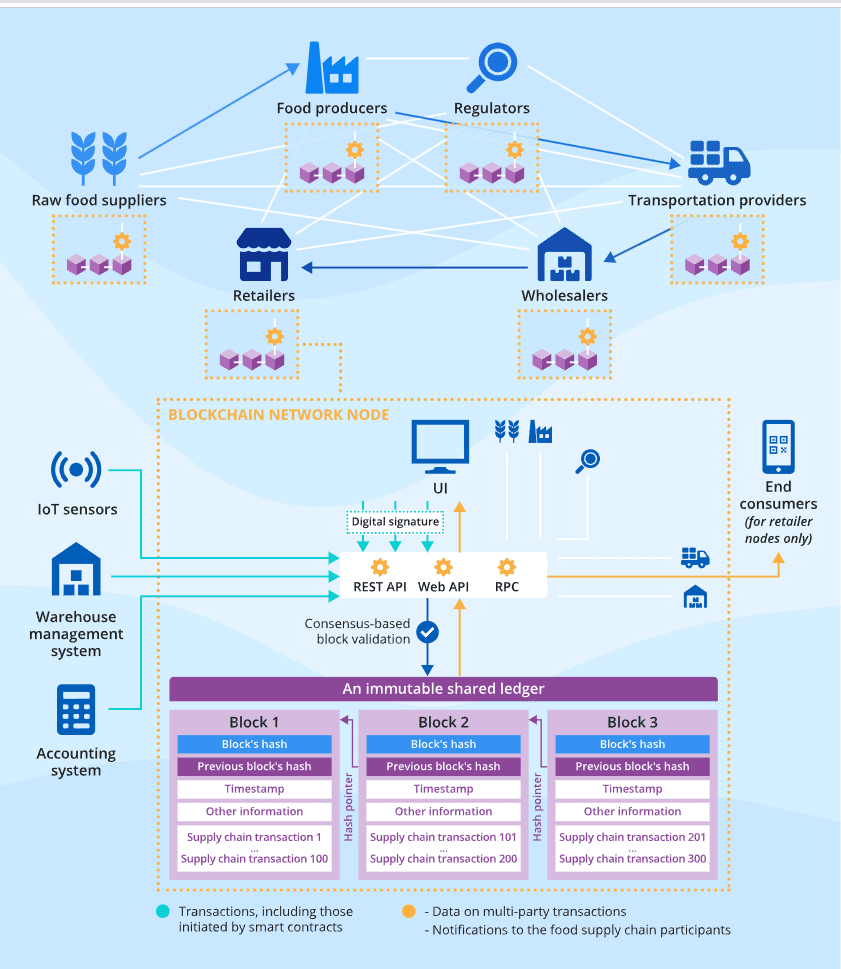The Crypto Garden: How Blockchain Changes the Agriculture

Turns out crypto is suitable not only for meme coins and market manipulation, but also for maintaining the high quality of the food you are getting. For over 5 years technology powering Ethereum, NFT’s and Dogecoin has been solving the problem of agricultural digitalization. But how’s that possible and why blockchain is used for this purpose?
How can crypto be used with agriculture?
Turns out crypto is suitable not only for the meme coins and market manipulations, but also for maintaining high quality of the food you are getting. Bitcoin or Ethereum aren’t easily associated with sowing, watering plants and growing crops, but they are linked to the data management market of the agricultural sector. Valued at $268M in 2022 alone, the market for blockchain in the Food Supply Chain is projected to reach $1,8B by the end of 2029.
Transparency is the new norm in the agricultural market. Starting from January 2023, an update to the European Common Agricultural Policy (CAP) Act is in effect. The aim of this update is to keep an open record about the origins of food, nature of transactions and parties involved in the supply chain, thus increasing transparency of the operation. This change alone can trigger the launch of new agricultural crypto projects in the near future.
The agri market is vast, accounting for $4.5 trillion in 2023 alone and employing 40% of the total population. The cornerstone of the agri market is data control and validation, given that many contracts still rely on handshake agreements, handwritten records, and paper documents.This creates a breeding ground for food fraud and data manipulation, amassing $40B per year in damages worldwide. Additionally, according to the CDC there’s 48 million people suffering from food borne diseases in the US alone, which highlights the importance of food quality control even in the 21st century.
What problem does crypto solve in the agriculture sector? Before reaching the shelf, every product has to undergo the transportation process. It may not sound much, but there's a gap between the farmsite and the shelf of your local supermarket made up of bureaucracy, lost loads, handwritten notes and freight ships delays. Not to mention the process of debunking forged or invalid documents. These data and documents are then used by distributors and local shops to tell if the product is fresh or not. The agri market is built on a “just-in-time” delivery principle, so mismatch in reported data directly translates into financial losses.
Is the problem real or was it made up? Food Fraud is real and happens all the time, as evident by the Horsemeat Scandal which started in 2013 and continues to date. In summary, meat providers replaced pork and beef with horse meat without labeling it as such – which is highly illegal. Research from 2020 disclosed that for over 20 years, there have been more than 400 cases of meat fraud. Remarkably, 43% of these cases involved passing off low-grade meat as premium breeds. Further investigation by the EU's Food Fraud initiative revealed even more cases, including a $6M operation selling beverages made from rotten apples and a $2.5B/year eel meat counterfeiting operation.
Why is blockchain technology so beneficial for the agriculture sector? Essentially, it boils down to core features of blockchain itself: transparency, smart-contracts, traceability and a change-resistant data ledger. When each data point in the chain is timestamped and validated you can backtrack the whole supply route with 100% precision in mere seconds, rather than days. Because the data is kept in a decentralized fashion, no single party can influence the data in the ledger without triggering consensus mechanisms. Thus data elimination is no longer a problem.
Blockchain helps unite IoT, data management and validation in one place. The IoT market alone in the agri sector is valued at $13.6B in 2022 and expected to reach $33.5B by the end of 2023. Blockchain technology integrates IoT data output with governance mechanisms, enabling real-time data validation without the need for the middle man. This offers end-to-end control over the delivery chain, from field to fork.
How does blockchain work in the agri market and who’s using it?
What is Supply Chain and why does it need so much control? To put it simply, in the context of the agricultural market “Supply Chain” terms refers to a “Field-to-Fork” delivery and production process at scale. It takes into account interactions between brokers, farmers, on-site operators, storage silos, trucking companies, store managers, warehouses, on- and off- loading docks, freight ships and a multitude of other entities. The use of blockchain helps to keep a transparent record accessible by all parties at once, which eliminates room for human error. This record keeps everything in one place, from delivery documents and SKU’s, to the exact delivery route and growing conditions.
Let’s break down how blockchain works in the agriculture sector:
- Raw Food Suppliers, known as Farmers, provide data on food origin and its movement through the supply chain. They also include information on timing, strain type, and other data relevant to determining the quality of the food in question.
- Food Manufacturers provide data on the origin of products and ingredients being used, along with the manufacturing process;
- Inspectors and certification entities validate documents about product origin and quality right when they are uploaded;
- Transportation and logistics providers update the chain with location and storage conditions of each food item in transit in real time;
- Food Distributors use this data to ensure they work with responsible sourcing partners, and know underlying food quality before even seeing it;
- The end consumer can verify all the steps taken and access a full chronological record on how that product was grown, delivered, handled, stored and treated.

Blockchain architecture in supply chain management | Source: Scnsoft.com
Simply put — blockchain is leveraged by the agricultural market to empower retail farmers. By somewhat tokesining the trust, blockchain provides an additional layer of security to the farming operation. The whole thing helps newcomers to establish themselves by earning a positive reputation faster than by traditional means.
Enough with the theory — where’s blockchain actually used in the agriculture market?
India, Brazil, Spain, USA, China and Australia are either using or exploring blockchain technology to keep track of Food Supply Chains.
AgriDigital; Launched in 2015 in Australia, by Emma Weston, Bob McKay and Ben Reid, this blockchain solution helps simplify the grain supply management for local and global businesses. The project’s first milestone was a settlement of agri-commodity between farmers and buyers in New South Wales (NSW) through a blockchain in December of 2016. One of the main goals of AgriDigital is to help farmers get paid in time, but it also allows them to track on-site trucks, manage off-farm storage and sale contracts, while keeping data records fresh and updated in real time. How popular is it? Well, since its launch and up to the present day, the software has been used by 11,600 projects, which collectively have moved 85M tons of agri-commodities and reported $13B in transactions.
IBM Food Trust, launched in 2017, also called “IBM Sterling Supply Chain Intelligence Suite” is the solution made to harness the power of blockchain technology in farming. Originally, it was launched in 2016 as an experiment between Walmart and Tsinghua University to improve the way food is tracked across China. In two years time, it reached a milestone of 50 partners uploading the data of about 460 different food items. Notable names involved include Carrefour, Smithfield, Wakefern, Beefchain, Topco, and others. To date it is trusted by Coricelli and Antonello Produce. How easy is it to use? “All they need is a batch number or an invoice number, and we can give them a full history for that product,” said Adrian Antonello, General Manager of Antonello Produce.
Agriota E-Marketplace, 2020, India and UAE (DCMM). India has a long record of food exports, amassing around $39B only in 2019 alone. The Agriota marketplace is rather interesting, as it integrates auction principles with supply chain tracking and GTSM farm tile management. For example, this system can replace a defaulted party within a food contract without human interference. Together with escrow banking, a secondary market for food trading, and on-chain tax and compliance records, it helps retail farmers to actually earn a decent income. It is also beneficial to the DCMM trading market of the UAE, as it helps to ensure food quality and safety.
Another prominent startup from India is Farm2Kitchen, which is responsible for educating and empowering over 100,000 small farmers in India. Together with blockchain-based supply tracking, it allows to ensure trust and transparency within rural-grown products.
Sahyadri FPO – one of the largest farmer producing collectives in India, with $62M in yearly revenue. According to the rules of the FPO organization, they can promise farmers a 25% share from the final price of the sold goods. By leveraging blockchain technology, Sahyadri Farms tries to shave-off the friction costs in the supply chain and increase the farmer revenue to 50%.
Today, major market players utilize the technology behind blockchain to bolster confidence in food safety. It provides verifiable data about the origin of production and facilitates trustworthy contracts between farmers and buyers. Moreover, it ensures that related documents remain valid, attached, and simultaneously accessible to all parties.
Recommended

